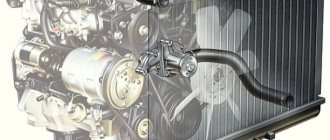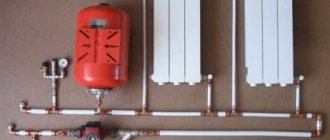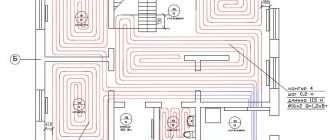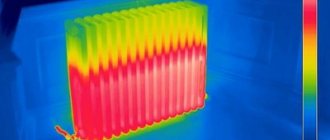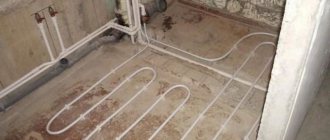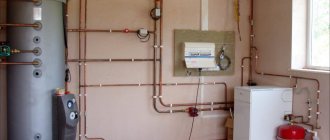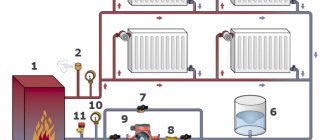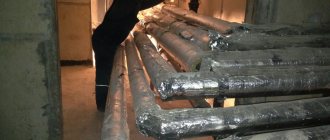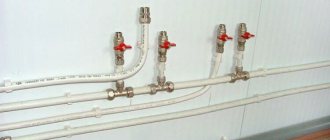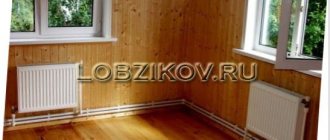Safety valve use
It is not the same as a safety valve. The latter simply relieves pressure in the system, but does not cool it. Another thing is the boiler overheating protection valve, which takes hot water from the system, and instead supplies cold water from the water supply. The device is non-volatile, it is connected to the supply and return mains, water supply network and sewerage system.
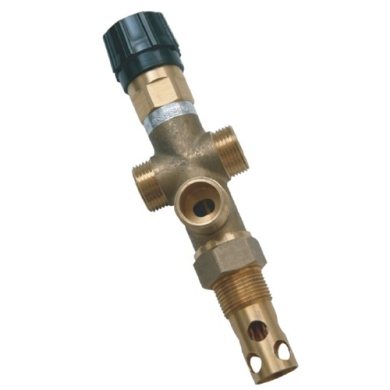
At a coolant temperature above 105 ºС, the valve opens and, due to a pressure in the water supply system of 2-5 bar, hot water is displaced from the jacket of the heat generator and cold pipelines, after which it goes into the sewage system. How the solid fuel boiler protection valve is connected is shown in the diagram:
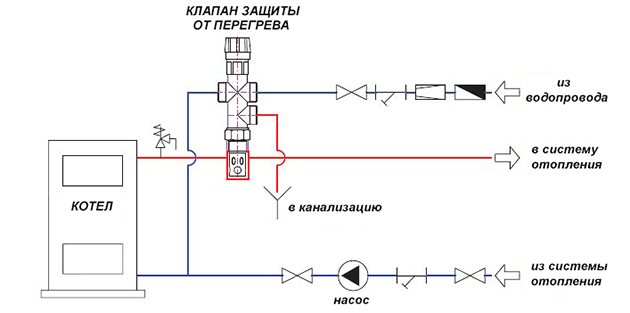

The disadvantage of this protection method is that it is not suitable for systems filled with antifreeze liquid. In addition, the scheme is not applicable in conditions where there is no centralized water supply, because together with a power outage, the supply of water from a well or a pool will also stop.
Classification of thermostats
For the reliable operation of wired thermostats, special attention must be paid to the high-quality installation of conductors.
This must be done to ensure uninterrupted communication with the boiler. The signal arriving at the thermostat triggers the process of supplying the heating medium to the heating circuit.
According to their design, thermostats are divided into the following types: wireless and wired.
In wireless devices, the regulation of the work process is carried out by using a radio signal
, which enters the thermal sensor.
Usually, there are two blocks as part of a thermostat for heating boilers. Installation of one of them is performed in the immediate vicinity of the boiler, it is connected by its terminals.
The other is installed in a heated room. These two blocks communicate with each other via a dedicated radio channel. The main difference between the main unit and the executive unit is the presence LCD and keyboard
.
Automation classification
According to such a criterion as the level of automation, thermostats are divided into the following groups:
- Analog.
- Digital.
The characteristic features of analog devices are that they are manually controlled, for which they are used mechanical regulator
which is directly connected to the rheostat.
Through microcircuit signals
the digital device is controlled. The use of equipment of this type allows you to use a large number of temperature modes during the operation of the heating system.
Classification by sensor type
Depending on the sensor installed in the thermostat, the models of these devices are divided into mechanical and electronic sensors.
Devices equipped with mechanical sensors are presented on the market capillary thermostats
... They calculate the temperature according to the change in the total volume of the heated liquid in the sealed flask. Such a sensor is immersed in a heat exchanger located in a heating device.
The main positive characteristic is precision and durability
... As for the shortcomings, the main one can be considered incompatibility with programmable controllers.
If an electronic sensor is installed in the thermostat, then when the controller is operating, it will read signals from the thermistor.The thermistor itself measures resistance under the influence of temperature.
What is the danger of condensate for the boiler
When firing up a solid fuel boiler, one has to face the fact that a cold coolant washes the walls of an already heated combustion chamber, cools them, which leads to condensation of water vapor, which is invariably present in the flue gases. Particles of water interacting with flue gases form acids, which leads to the destruction of the inner surface of the combustion chamber and chimney.
But the negative effect of condensate is not limited to this: soot particles that settle on the walls dissolve in water drops. Under the influence of high temperatures, this mixture is sintered, forming a dense and strong crust on the inner surface of the combustion chamber, the presence of which sharply reduces the intensity of heat exchange between the flue gases and the coolant. The boiler efficiency drops.
Removing the crust is not easy, especially if the boiler's combustion chamber has a complex heat transfer surface.
It is impossible to completely eliminate the formation of condensate in a solid fuel boiler, but the duration of this process can be significantly reduced.
Design
A typical boiler safety valve has a collapsible design and consists of the following main elements:
Housing. It is usually made of brass and looks like a tee. On its sides there are a lower threaded inlet, a lateral outlet pipe and an upper seat, on which the shaped seal is seated.
Locking group. It is a spring-loaded pulley with a cylindrical (disk) end locking element, on which an elastic rubber seal in the form of a cup (disk) is put on.
Cap. A black heat-resistant polymer cover is screwed into the upper threaded branch pipe of the brass body, which holds the spring-loaded stem in the working position. On the upper edges of the lid there are projections along which the top cap shaped in the lower part, connected to the shut-off rod, slides. When turned through a certain angle, the cap rises together with the stem and opens the side branch pipe - this allows the safety valve to be used for heating always open in manual mode.
Cap. The polymer part is usually red in color with a ribbed lateral surface, screwed to a hollow stem with a screw. The shallow protrusions in the lower part of the cap, when it rotates, fall on the teeth of the cap - the handle rises together with the spring-loaded shutter and opens the side channel, allowing manual pressure relief.
Adjusting washer. The inner wall of the cover has a thread, in which the adjustment nut rotates, when it is lowered down, it compresses the spring - thus increasing the valve response threshold. By unscrewing the nut upwards, the spring is weakened and the response pressure decreases. For turning, the nut is equipped with a transverse slot in the upper part for a flat screwdriver.
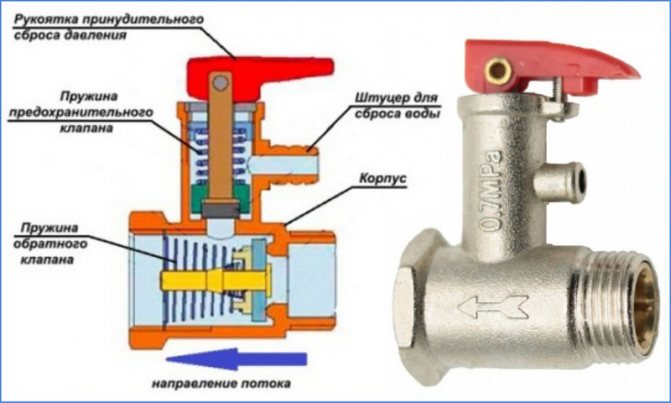

Valve for water heating boilers - design and appearance
Principle of operation and types of valve actuators
The product is produced in different configurations and with different actuators, but the principle of operation of the three-way valve remains the same: mix two streams with different temperatures into one, the temperature of which is set by the user or is required according to the scheme. The liquid inside the valve flows from one branch pipe to another until its temperature changes and reaches the set value. The actuator then gradually opens the flow from the third port, keeping the leaving water temperature within the set value. On this basis, such a valve is called a three-way valve.
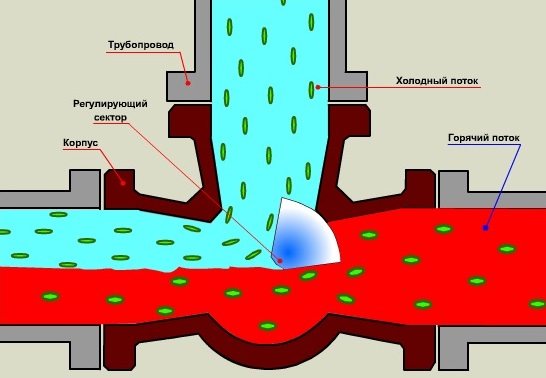

Three-way valve working principle
Any 3-way mixing valve has two inlets and one outlet.The distribution of streams is carried out using a drive, which is of several types:
- The thermostatic actuator (thermostat) is one of the most popular, it works due to thermal expansion of the sensing element, as a result of which there is a pressure on the valve stem and the liquid begins to mix.
- A widespread type of actuator, which is installed in a three-way changeover valve, is electric, it operates from a signal from the control unit.
- The valve can be operated by pushing the stem down with the thermostatic head actuator. It reacts to the air temperature, which is determined by itself or with the help of an external sensor and a capillary tube. The drive is most commonly used in underfloor heating systems.
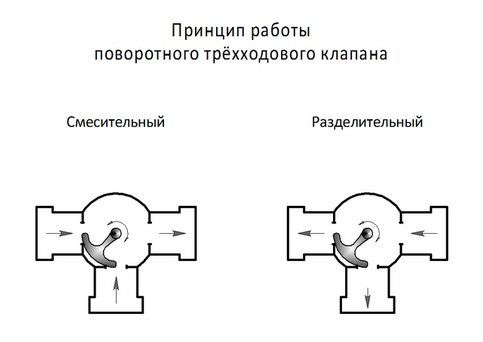

Stationary solid fuel boilers cannot be directly connected to the heating system. One of the reasons is that cold water must not be allowed to enter the boiler jacket until it has warmed up. Otherwise, condensate is released on the walls of the furnace, which, mixing with the ash, forms a strong layer of carbon. It prevents free heat exchange, reducing the efficiency of the installation, and it is very difficult to remove carbon deposits. The second reason is that you need to protect cast-iron furnaces from temperature drops in the event of an unexpected shutdown of the pump due to a power outage, and then start it up. The task is not to let cold water into the hot boiler, for which a three-way valve is needed. It will make the coolant circulate in a small circle until it heats up, and only then will it mix in cold water.
How does the thermostat work
The principle of operation of the device from different manufacturers does not have any significant differences. They may even have the same appearance. The difference is only in minor details. In terms of functionality, they practically do not differ from each other.
When the device is in operation, coolant heating control
and ambient air, for which a sensor is used, which can be built-in or external. The controller sends a signal to turn off and on to the automatic unit installed on the heating boiler.
A shutdown signal is given if the temperature of the heating medium or ambient air rises above the set value. When it falls below a predetermined level, then a signal is given to turn on
heating equipment.
Features of installation work
If the owner decided to install a thermostat in the heating system, then this work can be done by hand. It is advisable to install the device in the coldest part of the house or where the people living in the house are most often located.
Usually the installation of this device is made in a place convenient for use and in which easy access to it is provided.
Before installing the thermostat for the boiler, choose a place to which constant air flow
... This is necessary to ensure that it works correctly.
A solid fuel heating boiler is an option for those who want to have an autonomous, inexpensive heating system in their home that does not depend on gas supply and electricity. The main thing is to stock up on firewood, coal, wood pellets, sawdust and other solid combustion products, on which the boiler will operate. And thanks to the process of long burning of solid fuel, the temperature in the house will always be necessary, and in order to control and regulate the temperature in the house, of course, you will need a thermostat.
How to choose the right one
Before proceeding with the direct purchase of a valve, you should find out a lot of points regarding the boiler used and the features of the heating system, this will increase the efficiency of the system, otherwise it can lead to a deterioration in standard performance.
The main thing in this matter is to determine the operating parameters of the coolant (this is easy to find out using the available documentation). In addition, it is necessary to take into account the heating consumption and the piping scheme itself.
You can determine the flow rate and temperature of the coolant using the design documentation. If there is none, you can use the recommendations that are indicated in the passport of the boiler itself, which is used in the system.
All these parameters are needed in order to choose the right valve (you have to choose purely in terms of throughput).
The drive control system is selected according to the type of heating system and the piping of the boiler itself. The simplest models and options involve the use of a conventional thermostatic valve (although there are exceptions). And, as already mentioned, to ensure high-quality operation of floor heating, you should use a product with a thermostatic head.
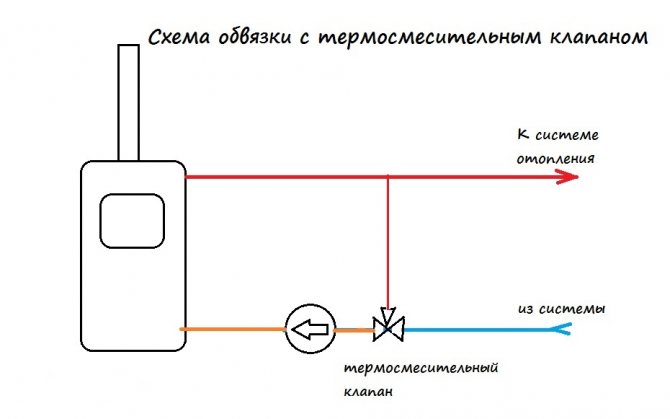

If you plan to work with a complex piping system, then manufacturers recommend using a valve with an external control controller.
Be that as it may, any modern heating system must use a three-way valve, which is an important component in the entire system and there is simply nothing to replace it with - no alternative has been invented.
An exception can be called the previously used elevator systems, which have not been used for a long time and are considered obsolete (due to their low efficiency and convenience).
Be sure to take into account that there is not only a mixing valve, but also a separation valve. The first option considered above implies the possibility of mixing two streams into one, and the second option, a separating valve, offers the ability to divide one stream into two, while regulating the flow to each of the outlets.
Both of these types of valves can be used in the system. However, a mixing valve is necessary in any case, and a separating one is rarely used in simple heating systems.
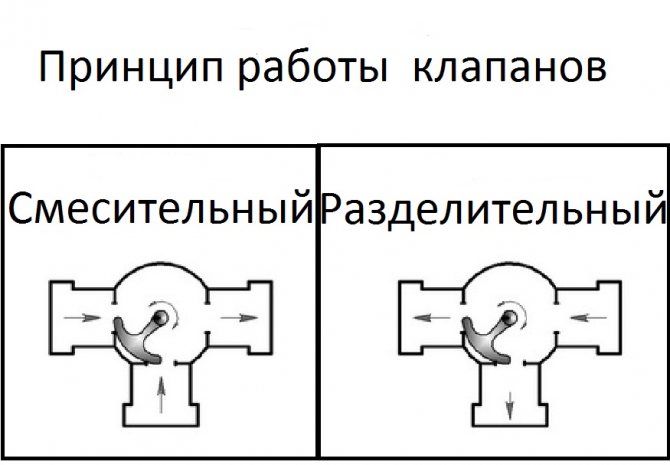

The correct choice of valve can be called in the event that the user chooses to purchase not only in terms of throughput, but also in terms of temperature. If the first selection criterion is the main one - without taking it into account, one cannot count on the functionality of the system as a whole, then the second criterion implies the duration of the valve's operation - if it is not designed to function in a system where the temperature is higher than the allowable temperature of the valve itself - the part will wear out faster and will require replacement, or will not function at all.
An autonomous heating system is a much more complex mechanism, consisting of a large number of interconnected components and assemblies that perform the corresponding functions. The three-way valve for the boiler in this mechanism plays the role of a mixer, in which the temperature of the coolant is regulated.
This is done so that the pipes are evenly heated and the heating level in each room is approximately the same. If you do not use the part, it will turn out that the water, when passing through the heat exchanger, will not heat up equally, and as a result, some of the rooms will receive less heat energy than all other rooms.
Heating boiler control in a house, apartment or cottage
Updated: Wed, Feb 08, 2017
What makes it possible to control a heating boiler?
Heating temperature regulation on the boiler panel
Room thermostats
Remote control of the boiler via the Internet and GSM
Boiler control via OpenTherm interface
Weather-dependent control
Boiler controllers
Smart home systems
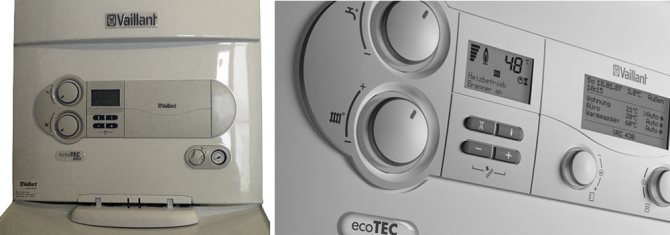

To ensure a comfortable stay and save heating costs, various devices and systems have been developed for automatic control of the heating boiler, the most popular of which will be discussed in this article.As a preface, we will cite a specific case that happened quite recently. While visiting a small country house with a large group of friends, our employee noticed that it was gradually getting too hot in the dining room where everyone was seated. Opening the windows, of course, was undesirable because of the danger of the guests getting cold. The owner of the cottage regularly ran into the annex and controlled the heating boiler manually, lowering, as he put it, "the temperature of the heating water." When asked why he would not install a room thermostat for a heating boiler or a thermal head for radiators in the house, the friend threw up his hands and said that he had no idea about these devices and why they were needed. But that's not all. In the middle of the night, the owner had to wake up and ask him to "add heat": the guests were simply freezing due to the fact that the night temperature dropped below -20 degrees, and the boiler was muffled and did not produce the power required for these conditions. All this "fuss" around the boiler was the reason for writing this article. It will only describe the boiler control automation, about room thermostats, thermal heads for radiators and automation for the heating system and underfloor heating You can find out by following the corresponding links.
Don't you understand how it works? Are you afraid to make the wrong choice of equipment?
You can always consult Moscow on boiler control automation, radiator heating or underfloor heating, as well as purchase this product or order its installation! Call +7 or contact through the form Feedback and our experts will advise you completely free of charge!
To begin with, let's find out in general terms what the electronic control of boilers gives? Automatic control of the heating boiler provides ample opportunities, such as:
- Room temperature control directly via the boiler control panel, i.e. directly from the thermostat panel. In this case, the user does not need to constantly approach the heat generator, because the control panel can be mounted in a convenient and accessible place.
- Maintaining comfortable temperature conditions that do not depend on external thermal factors (drop in outside temperature, heating of the house by the sun, the presence of a large number of people). The room will be automatically maintained at the temperature set by the user
- Saving energy resources, fuel and increasing the service life of heating devices by reducing the operating time of the heat generator
- The ability to automate the heating system and combine it into a single system (controllers and smart home)
- Monitoring the operation of heating equipment remotely, the ability to remotely control its various elements, prompt response to emergency situations (breakdown, blackout, etc.)
All of the above advantages unambiguously give the answer "yes" to the question - is a boiler control system necessary? Further, using examples, from simple to more complex, we will deal with various control systems for heating boilers.
Heating temperature regulation on the boiler panel
This is the simplest and least efficient way to regulate. How does a person usually operate a boiler without additional automation if it becomes hot or cold in the room, or, for example, it is necessary to leave home and lower the temperature in the rooms to save fuel costs? To do this, the user approaches the boiler and begins to adjust the "heating temperature" on its panel (boiler panel drawing), although many do not realize that in this way they control the degree of heating of the coolant in the system, and not the exact temperature of the air in the room. For example, a standard 24 kW gas boiler and several radiators are installed to heat a one-room apartment.To heat the coolant in the system to the set temperature, the boiler will take several minutes after which it will turn off. Then the water in the radiators quickly cools, causing the boiler to switch on and off frequently, respectively. This mode of operation increases gas consumption and negatively affects the resource of the boiler.


A few more disadvantages of this adjustment: - You have to constantly approach the boiler, which may be located in a remote place: in an annex, basement, a separate room. Sometimes adjustments have to be made at night, which, you see, is very unpleasant. - Since the user only sets the temperature of the heating medium, any thermal effect on the room changes its thermal comfort. For example: then the sun suddenly peeking out begins to "heat up" the room additionally, then a decrease in the outside temperature begins to cool it down, then the presence of guests increases the temperature, etc. - The boiler heats the coolant to the specified temperature values, despite the fact that in the heated rooms a comfortable temperature has already been reached, consuming excess electricity and fuel and, naturally, reducing its resource. How can these problems be resolved? It's very simple, you just need to buy and install a room thermostat.
Boiler control with room thermostat
In the article, we will not describe in detail the principles of regulation and types of room thermostats, but we will note only the most important points.
More information about room thermostats and programmers
When installing and connecting a room thermostat to the boiler, the operating mode of the heating system will depend on the air temperature in the room where it is installed... A thermostat for a heating boiler is a boiler control panel, on which the user sets the required air temperature in the room (namely the temperature of the air, not the coolant). If the air temperature becomes higher than the set one, the thermostat turns off the boiler, if it is lower, it turns it on. Since the room cools down much longer than the coolant, the frequency of switching on the boiler decreases, which means its resource increases. Fuel consumption is reduced accordingly. The advantages of using a thermostat for a heating boiler:
Saving fuel (gas, diesel) from 15% to 30%. The spread of numbers is associated with various external conditions, such as: the degree of insulation of the house, the outside temperature of the air during the heating season, the number of days spent in the house of its residents, etc.
- Controlling an electric boiler using a thermostat can significantly reduce the cost of heating a house, since electricity is the most expensive type of "fuel".
- The operating time of the circulation pump is reduced, which also saves on the electricity it consumes.
- Temperature comfort in the room.
- Possibility of setting weekly cycles for programmable thermostats.
- The ability to control the boiler via the Internet or GSM, notification of malfunctions in the heating system.
Room wireless thermostat with weekly programming Salus 091FLRF
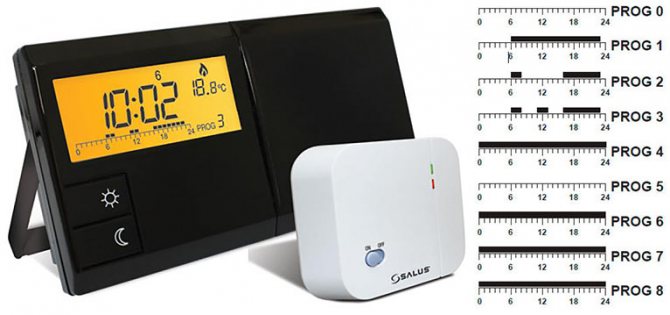

Thermostats for remote control of the heating boiler
The heat generator can be operated without being near it. For this, thermostats are used, controlled via the Internet or GSM-mobile connection. WiFi thermostat, controlled only via the Internet, requires, of course, the presence of a Wi-Fi network in the house. The photo below shows some models of popular thermostats for remote control of a heating boiler
Room wireless internet thermostat Salus iT500
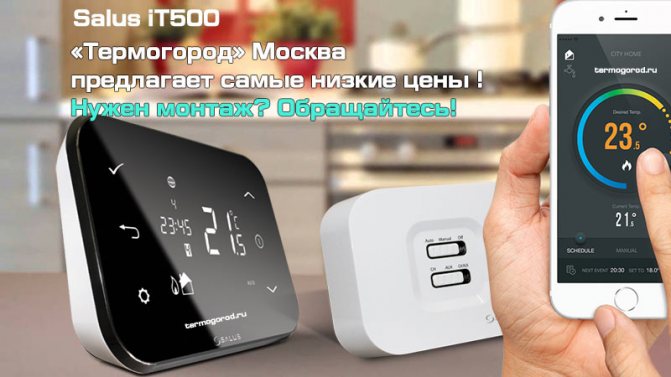

Room wireless internet thermostat ZONT-H2
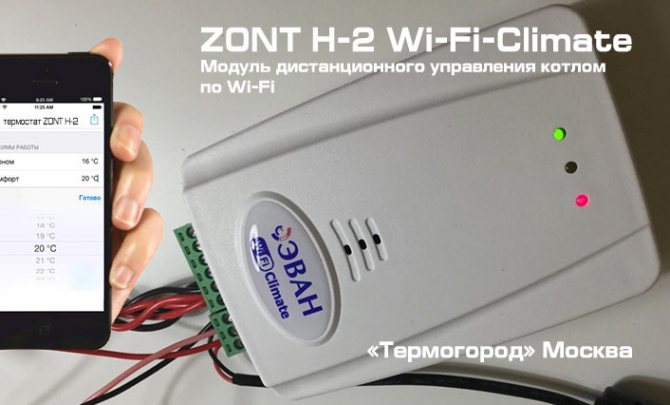

Thermostat controlled via GSM communication, is used to control a heating boiler in the absence of a Wi-Fi network in a country house or in the absence of the Internet at all.For its operation, you need a SIM card of any operator (Megafon, Beeline, etc.) and a GSM phone, preferably with paid access to the mobile Internet. No mobile internet? It does not matter, the GSM thermostat can also be controlled by sending special SMS messages to the number of the SIM card installed in it from the predetermined trusted phone numbers or from other numbers, but with an additional indication of the password. There is another possibility of controlling the boiler using a GSM thermostat - control from the phone when dialing the voice menu of the sim card of the thermostat.
GSM thermostats: detailed information, cost and installation
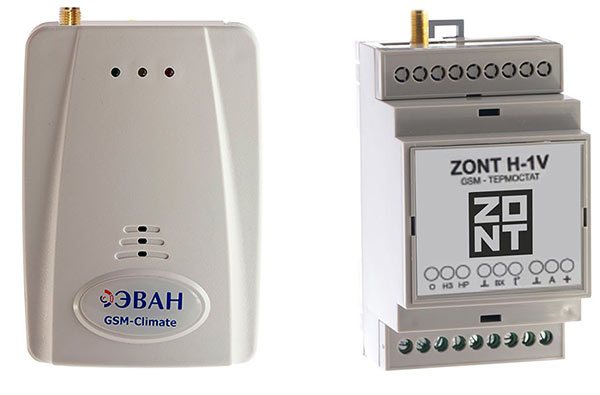

When installing a thermostat to control a heating boiler, the user should carefully consider the place of its installation. The control panel for a gas boiler (or any other) should be installed in an easy-to-use place (preferably in a place that is hard to reach for children), where it will not be influenced by other heating devices or, for example, direct sunlight (insolation).
Do you want to buy a boiler control?
Moscow specialists will advise, help you choose and install a thermostat for a heating boiler at your request! The product line includes all types of thermostats, including thermostats controlled via the Internet and GSM communication! Call +7 or contact through the form Feedback and our experts will advise you completely free of charge!
Boiler control in the Smart Home system
Smart home systems with the ability to control the boiler and the heating system as a whole are the pinnacle of engineering in terms of automating the operation of heating equipment. Since a separate article will be required to describe the operation of at least one of them, here we will clarify to users only the advantages of operating such a system and analyze one of them. Smart home systems allow: - Control the operation of the heating system in each room, and sometimes part of it. In other words, they allow you to provide multispectral heating control, moreover, also with the integration of heat consumers into separate groups with an independent control mode. - Provide maximum comfort (even a separate radiator can be adjusted). - Remotely control the temperature of the air and underfloor heating in a separate room from a single remote control, phone or computer. - To save as much as possible and rationally distribute heat resources. - Integrate the heating system with air conditioning, humidification and ventilation systems. - Possibility to additionally control lighting, alarms, opening doors and gates, curtains, etc. - Avoid running control cables throughout the house and also reduce installation costs by making the most of wireless sensors. - Do not spoil the look of the dwelling - the design and color solutions of the system elements elegantly fit into the furnishings of the premises.
The Termogorod Moscow company was one of the first to introduce on the market a multi-zone control system "smart home" Salus IT600 Smart Home
Buy heating control system Salus IT600
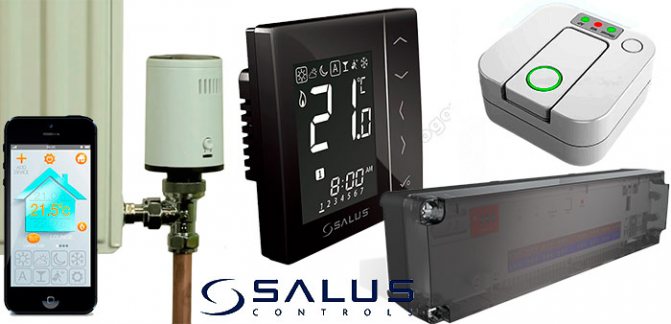

The capabilities of this system can solve the widest range of tasks: - Controlling the temperature of heating and underfloor heating in each room (up to 50 thermostats). - The ability to connect any electrical appliances (lights, roller shutters, kitchen appliances, gates, convectors, TVs, etc.) - Remote control of heating, underfloor heating and electrical appliances (up to 100 pieces) using a telephone or computer. - Integration into the system of sensors for opening windows and doors - Wireless location of thermostats and control points - A wide range of electronic wireless thermostats will provide accurate temperature measurement and ease of use. Read more about the system and its capabilities in the article: Smart House.Heating control system Salus iT600
Boiler control with OpenTherm function
A distinctive feature of these thermostats is the ability to connect to boilers that support the OpenTherm communication protocol. OpenTherm is a modern control technology with a simple installation procedure and high functionality, which consists of a communication protocol and special technical regulations. Opentherm devices can be identified by special OpenTerm logo (fig. on the right). The presence of the logo guarantees a minimum level of interaction between the boiler and the room thermostat, the degree of interaction depends on the specific model and protocol version. Thermostats with the OpenTherm function are only compatible with boiler models that support this protocol, therefore, the user must specify this information when purchasing or in the boiler passport.
How do OpenTherm thermostats work? Conventional thermostats work in relay mode, that is, they simply turn on or off the boiler. When turned on, the boiler burner starts to work at full power, which leads to a certain overconsumption of heat, since such an amount of air is possible and not needed to heat the air in the room. When the boiler is turned off due to the inertia of the heating system, pipes and radiators continue to give off excess heat, due to which the temperature in the room will for some time be higher than the one set on the thermostat, although the boiler has already been turned off. In both cases, there is an overconsumption of thermal energy, which reduces the savings from the use of automatic boiler control.
Boiler control without OpenTherm function
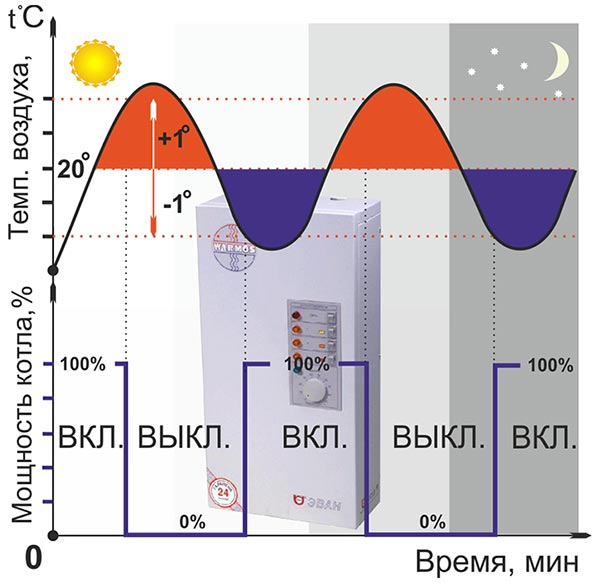

When operating a boiler with an OpenTherm interface, the thermostat does not turn on or off the boiler, but constantly modulates (changes) the combustion power of the burner, depending on the heat demand. The thermostat measures the ambient air temperature and, if it decreases, increases the combustion power, and if it increases, it decreases it. At the same time, the boiler gives off as much heat as is required at the moment to the system, which gives additional savings and comfort to the user.
Boiler control with OpenTherm function
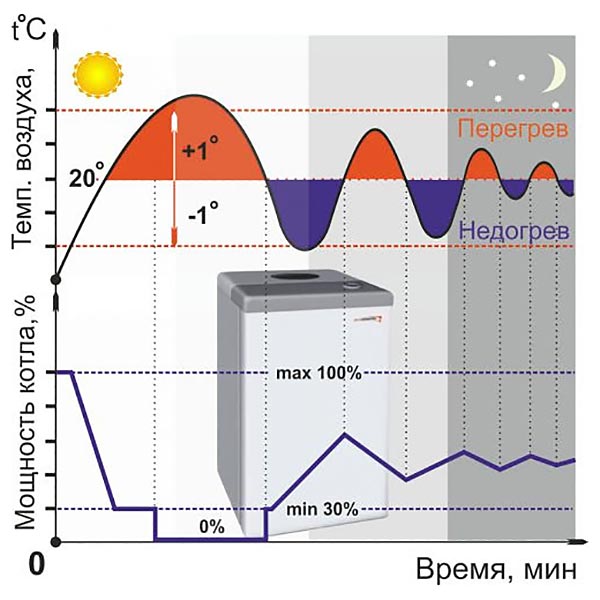

The thermostat in the hysteresis zone constantly calculates how much the actual temperature has deviated from the set one, and the greater this difference, the more burner power it commands the boiler to develop. If it goes beyond the hysteresis limits, it completely turns off or turns on the burner, and within its limits it will smoothly control the burner power. That is, the process of alternating periods of subcooling and overheating will be "damped", all the time automatically striving for an equilibrium state, when the boiler at any time gives to the heating system exactly as much heat as is required to compensate for the current heat loss of the room. In this way, the room temperature remains at a constant set level. For the boiler in particular and for the efficiency of the heating system as a whole, this is much better, because it is much more profitable to work continuously at a reduced power. As a result, compared to boilers without an OpenTherm interface, up to 30% of fuel can be saved during the heating season! For reference: Hysteresis (dead band) - the range, which is set to the higher and lower sides of the set temperature value, in which the thermostat does not react in any way to changes in the actual temperature. For example: the room temperature is set at 20 ° C. With a hysteresis of ± 1 ° C, this means that the thermostat will control the heating boiler only when the temperature measured by it falls below 19 ° C or rises above 21 ° C. If the measured temperature value is in the range of 19 ° C - 21 ° C, then the thermostat will not react to this and, accordingly, will not give commands to the boiler.
Weather-compensated heating control
Serious battles have been fought about the use of weather-dependent automation for heating boilers on the Internet. Some “experts” are unequivocally “For” its use, others are no less categorically “Against”. Where is the truth? And as always in the middle.Remember the heated discussions about whether you need a TV remote control. Hotheads even then proved that it was money thrown into the wind ... It is interesting to listen to their opinion now 

Now more and more modern heating boilers can operate in a weather-dependent mode. To do this, the user needs to make sure that his boiler supports this functionality (check with the seller or in the boiler passport). If it does, then you are in luck, and you just have to additionally buy and install an outdoor temperature sensor, and if not, then you need to purchase a weather-dependent boiler control controller (see below), well, and an outdoor temperature sensor, of course, too. In both cases, it is highly desirable to have a room thermostat in the house. The weather-dependent control of the boiler allows you to increase the temperature comfort in the room due to the fact that the change in the outdoor temperature is taken into account and the coolant is pre-heated (or not) to the temperature that heats the air in the room to the value set on the thermostat. If there was no outdoor sensor, then the boiler would be guided in its operation only by the data of the room thermostat and it would need additional time to heat the coolant, which would lead to a certain subsidence of thermal comfort in the room due to the inertia of the heating system. Since the boiler only heats up the heating system to a predetermined value, and does not "accelerate" it when the thermostat turns it on, additional savings are 10-15%, even taking into account the room thermostat already installed in the house.
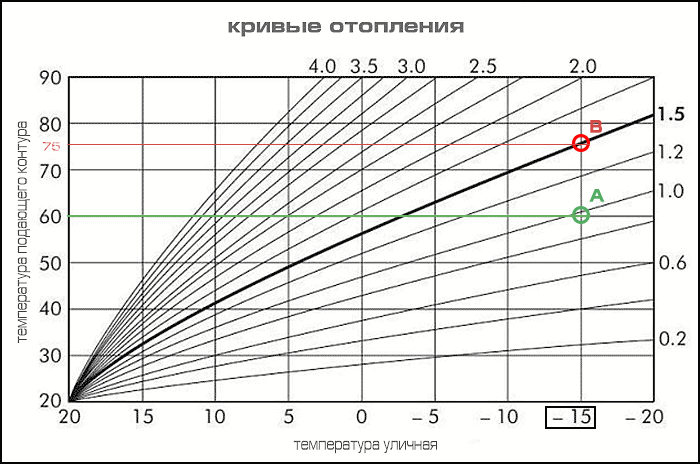

In general, the operation of the heating system depends on many factors, and, in particular, on the quality of the thermal insulation of a particular building.General thermophysical laws are applied to the system, which make it possible to calculate the relationship between the outdoor temperature and the temperature of the coolant. But there is one unknown parameter, which depends on a particular room. It is chosen experimentally so that at a certain outdoor temperature, the expected temperature of the coolant is obtained. Since there is an unknown parameter, then this dependence can be described not by one graph but by a whole family of curves. The basis of the weather-dependent automation algorithm is the use of predefined pre-calculated curves that relate the temperature outside the house and the temperature of the coolant. The choice is made empirically, in other words, it is simply selected experimentally. Since a house is an object with a large thermal inertia, the result of the choice can be clear in about a day. If it turns out that the house is underheated, then a steeper heating curve is selected and vice versa. For example, consider a situation when the user selects the indoor mode + 21˚С at -15˚С "outdoors" (in fact, the operating parameters of the system must correspond to the calculated coldest day of the year). Under such conditions, the boiler setting, for example, will be performed so that the temperature of the coolant in the system is at the level of + 60˚С, which means that it is necessary to choose a graph in which the curve will pass through the point under the specified conditions A (curve 1.0)... A situation is possible when the setting of the heating system will be such that at the same -15˚С outside, the temperature of the coolant will need to be at + 75 понадобитсяС (for example, the house is poorly insulated or an insufficient number of radiators are installed in the premises). In this case, the curve will have a more "steep" character, passing through the point B (curve 1.5)... Another fixed point for all curves is the indoor temperature + 20˚C at + 20˚C outside. It is generally accepted that with such parameters, there is no longer a need for heating the room. On all other days, the weather-dependent automation will set the coolant temperature in accordance with the current needs according to the selected curve.
If you use only a room temperature sensor, then the inertia of the thermal control system will increase, and the control accuracy will decrease. He simply will not be able to "see" the change in the outside temperature and the temperature in the room will change with a delay, since the automation will start to operate only when the temperature in the house, for example, drops, and this will happen much later than the actual cold snap outside. Weather-dependent automation in this respect is much more flexible and does not require constant attention from users. The presence of two sensors at once, both indoor and outdoor, allows you to more accurately track and quickly adjust the temperature in the premises.
In practice, the PZA algorithm works even more complicatedly, since the dependence of the coolant temperature on the outside temperature is not enough. For example, a room can be heated by the sun (insolation) or, conversely, cooled down due to an open window. Having a lot of people will also increase the temperature in it. Therefore, in practice, such a PZA curve is chosen so that it is exactly enough to heat the room, that is, with a margin. Further, when the air temperature in the house becomes close to the set one, then the usual algorithm for maintaining the room temperature comes into operation. In this case, the coolant temperature calculated from the curve becomes the maximum value (upper threshold). The work on maintaining the room temperature is reduced to turning on and off the boiler, but taking into account that the maximum temperature of the coolant does not exceed the calculated according to the PZA data.
The setting of the weather-dependent automation parameters (temperature graph or curve) is carried out by the installer on the boiler or controller panel, and the outdoor sensor is installed outside the house or cottage in places not exposed to sunlight (insolation) and other heating devices. Often, manufacturers of boiler equipment offer sensors of their own production for organizing weather-dependent automation for their boilers.
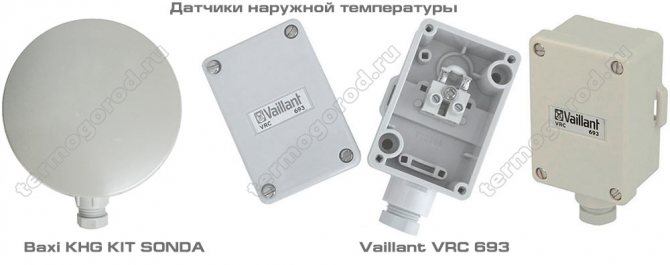

Boiler control controller
The next stage in the development of boiler control automation is the control controller.This is a kind of computer - an electronic control unit for the boiler, the heating system, hot water supply and underfloor heating (the controller's capabilities depend on the specific model). Since the functionality of each model and control methods are different, in this article we will only briefly present and describe the advantages of some of them. What if the house has complex heating systems with many circuits, if several objects are supplied with heat from one boiler (and most likely from a cascade boiler room): the house itself, a garage, a sauna with a pool? It is impossible to manage all this economy manually, and it is simply necessary to install a fully automatic heating control system. Well, or, as an option, pay for the work of a full-time specialist and not delve into all the intricacies of the heating operation. Unlike the operation of boiler thermostats, controllers allow you to regulate the temperature not only in one (or at best several) rooms, but throughout the house. This is achieved by regulating the operation of circulation pumps and three-way valves of heating circuits (for example, the circuit of the 1st and 2nd floors), control of the boiler circuit pump (also called the network pump), turning the boiler on / off and starting the boiler loading pump. The complete set of the controller usually includes: a boiler and heating control system (controller unit), temperature sensors, control cables and fixtures. In some cases, room thermostats and outdoor sensors are purchased separately. On the boiler control panel, the user can set the coolant temperature, turn-on time, hot water temperature, select a weather-dependent mode schedule, set up the operation of several boilers in a cascade, the heating level of underfloor heating, etc. The remote room controllers set the temperature in the rooms of each circuit separately. Example: The user on the thermostat sets the temperature in the bedroom of the second floor of the house (the controller will be guided by this data when regulating the temperature of the entire circuit of the second floor, including other rooms), on the second thermostat sets the temperature in the dining room on the 1st floor (the controller takes into account this data for heating circuit of the first floor), then sets the temperature of hot water in the boiler. As a result of these actions, the controller, based on data from thermostats, coolant temperature and street temperature sensors, begins to mix the return flow in one or the other direction of the coolant flow using three-way taps (more about this in the article control of the heating system), turns on / off the circulation pumps (1st or 2nd floor), starts heating the water in the boiler by turning on the boiler loading pump. Taking into account the above, the advantages of using controllers can be highlighted: - Automatic temperature control of various circuits (heating rooms and floors) - Maintaining thermal comfort in different temperature circuits (radiator heating, underfloor heating) - The ability to maintain the temperature of hot water supply (in the boiler, as well as in the distribution hot water collector or heated towel rail) - Linking all elements of the heating system into a single control center - Savings on fuel and electricity due to a balanced temperature distribution of the coolant and the operation of system elements. - Possibility to control a cascade of boilers.
Save up to 20% on heating costs!
If you do not know which programmer you need, this is not a problem! Set a task, describe your heating system - and our experts will help you choose and install weather-dependent automation or heating controllers.
One of the most popular in the Russian market is weather controller Salus WT100
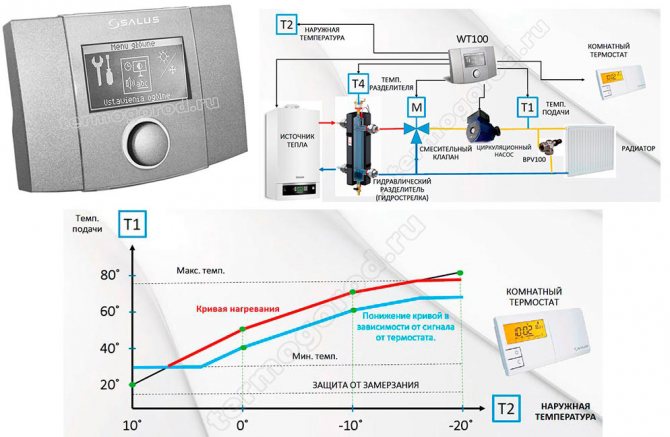

Briefly about its capabilities WT100: Controls one heating circuit (or underfloor heating circuit). It controls the operation of the boiler and the mains pump. Works in weather-dependent mode. Maintains a constant hot water supply temperature. Return temperature protection. Equipped with a programmable timer. Ideal for automation and control of heating or underfloor heating systems in a small house.
Buy weather controller Salus WT100
The next controller with an equally wide range of functionality is Kromschroder E8.0634
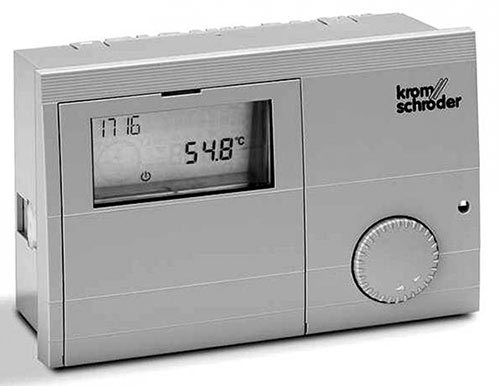

E8.0634 controller features: Controls the operation of 2 different heating circuits. It controls the operation of 1 or 2 boilers in a cascade, as well as a network pump. It can work in weather-dependent mode. Maintains the temperature of the hot water supply. Controls the operation of the boiler. Additional time-controlled output. Frost protection.
Strapping diagram Kromschroder E8.0634
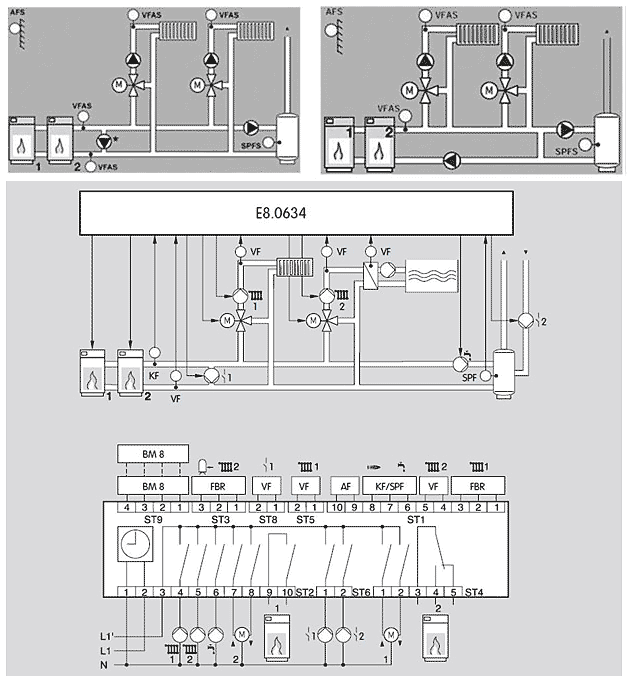

Examples and photos of completed works
Moscow specialists are familiar with boiler control systems firsthand. Extensive work experience, search for innovative products, careful selection of technical proposals, passing training seminars of manufacturers and a responsible approach to working with our clients - have allowed our company to collect a unique portfolio of proposals for almost any client! If you want to buy a control for a boiler, then you are on the website of a company that will really help you do this. Below are photos and examples of our work:


So, let's summarize. When buying and operating boiler equipment, the user should know that technologies of the 21st century can make his life much easier, bring comfort to it and save a lot of money on a seemingly simple thing like controlling a heating boiler. The heating automation segment does not stand still and pleases us with more and more innovative and technological solutions. Read, search, find out, write to us and ask - curiosity and inquisitiveness will eventually return with comfort and hard cash. 

- Back to
- Forward
Reasons that may result in overheating of a solid fuel boiler
Even at the stage of selection and purchase, it is important to take into account the operational characteristics of the heating device. Many models that are on sale today have a built-in overheating protection system
Whether it works or not is the second question. However, it is necessary to adhere to certain knowledge and skills, hoping to create an efficient and safe autonomous heating system at home.
The reliable operation of the heating unit depends on the operating conditions. In case of obvious violations of the technological parameters of heating equipment and abuse of standard safety rules, there is a high probability of an emergency.
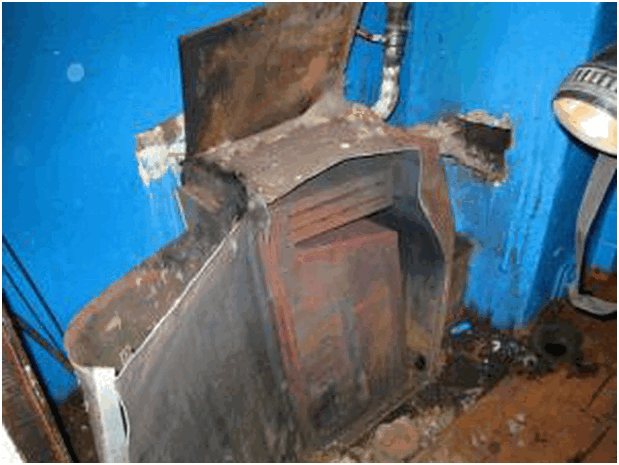

Possible negative consequences can be prevented even at the stage of installing a solid fuel boiler. Correct piping of the heating device will guarantee your safety and reliable operation of the unit in the future.
In detail, in each case, the solid fuel boiler protection system has its own specifics and features. Each heating system has its own pros and cons. For instance:
When it comes to solid fuel boilers with natural circulation of the coolant, it is necessary to take care of the safety and operability of the heating equipment even during installation. The pipes in the system are installed metal. Moreover, the diameter of such pipes must exceed the diameter of the pipes used for laying a circuit with forced circulation of the coolant. Sensors installed on the water circuit will signal a possible overheating of the coolant. The safety valve and expansion vessel act as a compensator, reducing overpressure in the system.
A significant disadvantage of the gravitational heating system is the lack of an effective mechanism for adjusting the operating modes of solid fuel boilers.
Large technological opportunities for consumers are provided by those working with forced circulation of the coolant in the system. Already only the presence of the second circuit significantly increases the ability to regulate the heating temperature of the boiler water. The only drawback in the operation of such a system is a working pump, which can make it difficult to operate the heating system with its work.
This is due to the fact that when the electricity is cut off, the pump stops performing its functions. The stoppage of the circulation process and the inertia of solid fuel heating boilers can lead to overheating of the heating unit. If the boiler equipment is not equipped, the situation with a power outage is fraught with extremely unpleasant consequences.
Effective protection against overheating of a working solid fuel boiler should be based on the mechanism for removing excess heat generated by the heating device.
What are the ways to protect heating equipment from overheating
Manufacturing companies try, in order to increase the consumer attractiveness of their products, to include any guarantees of its safety in the technical passport of boiler equipment. The uninitiated consumer does not have the slightest idea about the means of protecting the heating boiler from boiling.
There are currently the following ways to ensure the protection of solid fuel units used for autonomous heating systems. The effectiveness of each method is explained by the operating conditions of the boiler equipment, and the design features of the units.
In most cases, manufacturers recommend using tap water for cooling in the data sheet for a heater. In some cases, solid fuel boilers are equipped with built-in additional heat exchangers. There are models of boilers with external heat exchangers. Used by a safety valve to prevent overheating. The safety valve is designed only to relieve excessive pressure in the system, while the safety valve opens access to tap water when the boiler overheats.
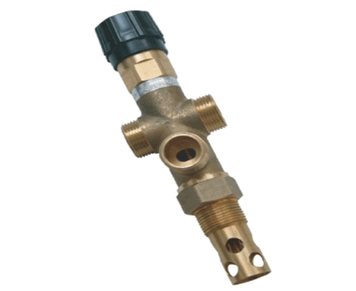

If the temperature of the coolant exceeds the 100 ° C mark, it creates an excess pressure that opens the valve. Under the influence of tap water, which is supplied under a pressure of 2-5 bar, hot water from the circuit is displaced by cold water.
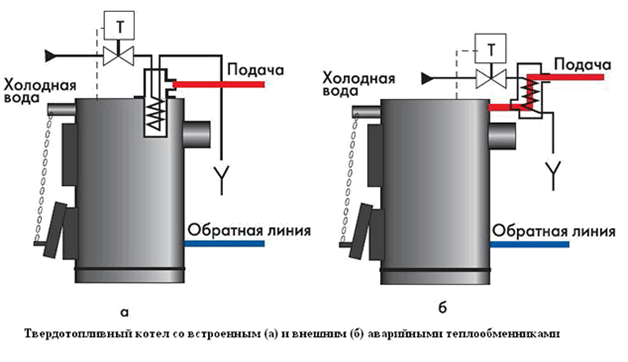

The first controversial aspect of tap water cooling is the lack of electricity to power the pump. The expansion vessel does not have enough water to cool the boiler.
The second aspect, which sweeps aside this cooling method, is associated with the use of antifreeze as a heat carrier. In the event of an emergency situation, up to 150 liters of antifreeze will go into the sewer along with the incoming cold water. Is this protection method worth it?
The presence of a UPS will allow maintaining the operation of the circulating pump in a critical situation, with the help of which the coolant will evenly disperse through the pipeline, without having time to overheat. As long as there is enough battery capacity, an uninterruptible power supply ensures that the pump is running. During this time, the boiler should not have time to heat up to the critical parameters, the automation will work, starting the water along the spare, emergency circuit.
Another way to get out of a critical situation will be to install an emergency circuit in the piping of a solid fuel unit. Switching off the pump can be duplicated by the operation of the reserve circuit with natural circulation of the coolant. The role of the emergency circuit is not in providing heating of residential premises, but only in the ability to remove excess heat energy in an emergency.
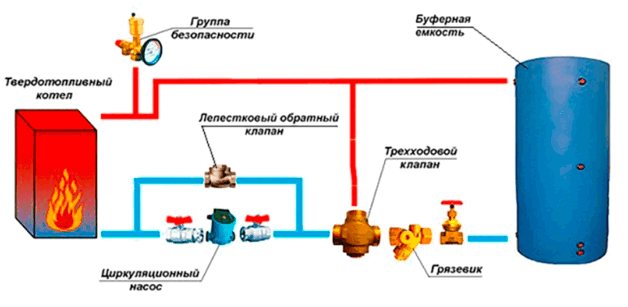

Such a scheme for organizing the protection of the heating unit from overheating is reliable, simple and convenient in operation. You will not need special funds for its equipment and installation. The only conditions for such protection to work are:
- the presence of an expansion tank or storage tank in the system;
- use of a check valve only of the petal type;
- the pipes in the secondary circuit must be of a larger diameter than the conventional heating circuit.
How to install
When installing the safety drain fittings, observe the following rules:
- Usually, a pressure relief valve in the heating system is installed in a household circuit in a single copy. Its main points of placement are directly above an electric, solid fuel, gas boiler at its outlet or next to a horizontally located pipeline. If this is not possible for technical reasons, the main condition for correct installation is installation in the supply line up to the first shut-off valve.
- The outlet side pipe is usually connected to a sewer or drainage system, if it is technically difficult or the volume of the coolant in the circuit is not high, you can use a flexible hose, which is lowered into a container of a suitable volume.
- The liquid must be removed with a rupture of the jet through a funnel or a hydraulic seal to ensure the system is operational when the sewer is clogged.
- For installation in a pipeline, use a BOTTOM tee of a suitable diameter, the standard being 1/2, 3/4, 1 and 2 inches. The diameter of the pipeline inlet to the valve must not be less than that of the system.
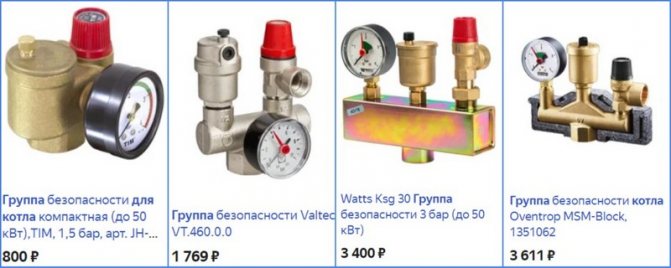

Valve safety groups - varieties and price
Device advantages
It should be noted that if a programmable thermostat is installed in the heating system of a private house designed for a gas boiler, then it has the following advantages over simple-type appliances:
When choosing any device for a boiler, first of all, it is necessary to build on the requirements that apply to its functionality.
If the serious functionality of the device is not important to you, then you can install a simple device in the heating system. In most cases, owners purchase programmable thermostat
due to its good functionality.
Valve types
So, in more detail about the two existing types of valves, you can read below:
- 1. The three-way thermostatic valve for the boiler is an automatic model. It will maintain the set temperature level without additional human intervention. At the same time, the most functional models are equipped with an additional security system that blocks the movement of the coolant if there is no circulation through one of the incoming pipes. Thus, boiling will not occur in the batteries.
- 2. The three-way thermo-mixing valve for the boiler can be completed with both automatic and manual control. The fundamental difference will be the need to regularly check the state of the system so that it does not overheat. To date, mechanical devices have already practically been abandoned, since they have been replaced by more advanced units.
Varieties
The existing types of valves are capable of working with boiler equipment from leading foreign (Vaillant, Baxi, Ariston, Navien, Viessmann) and domestic (Nevalux) manufacturers on gas, liquid and solid fuels in situations where automatic control over the operation of the system is difficult due to the type of fuel. or broken when the automation fails. Depending on the design and the principle of operation, safety valves are divided into the following groups:
- According to the purpose of the equipment in which they are installed:
- For heating boilers, they have the above design, they are often supplied on fittings in the form of a tee, in which a pressure gauge for checking the pressure and a vent valve are additionally installed.
- For hot water boilers, there is a flag in the design for draining water.
- Containers and pressure vessels.
- Pressure pipelines.
- According to the principle of actuation of the pressure mechanism:
- From a spring, the clamping force of which is regulated by an external or internal nut (its work is discussed above).
- Lever-cargo, used in industrial heating systems designed to discharge large volumes of water, their response threshold can be adjusted with suspended weights. They are suspended from a handle connected to the shut-off valve by the principle of a lever.
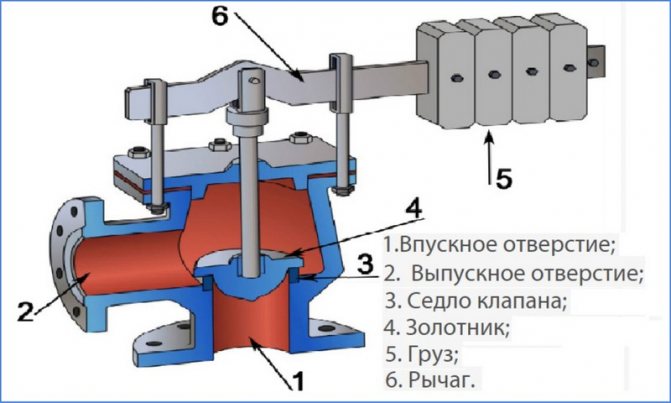

Lever-load modification device
- Locking mechanism response speeds:
- Proportional (low-lift spring) - the sealed lock rises in proportion to the pressure and is linearly related to its increase, while the drain hole gradually opens and closes in the same way with a decrease in the volume of the coolant. The advantage of the design is the absence of water hammer at various modes of movement of the shut-off valve.
- Two-position (full-lift lever-cargo) - operate in open-closed positions. When the pressure exceeds the response threshold, the outlet opens completely and the excess volume of the coolant is vented. After the pressure in the system is normalized, the outlet is completely closed, the main design flaw is the presence of water hammer.
- By adjustment:
- Non-adjustable (with caps of different colors).
- Adjustable with screw parts.
- According to the design of the adjusting elements of the compression of the spring with:
- An internal washer, the principle of operation of which was discussed above.
- Outside screw, nut, models are used in household and communal heating systems with large volumes of coolant.
- With a handle, a similar control system is used in flanged industrial valves, when the handle is fully raised, a one-time drain of water can be performed.
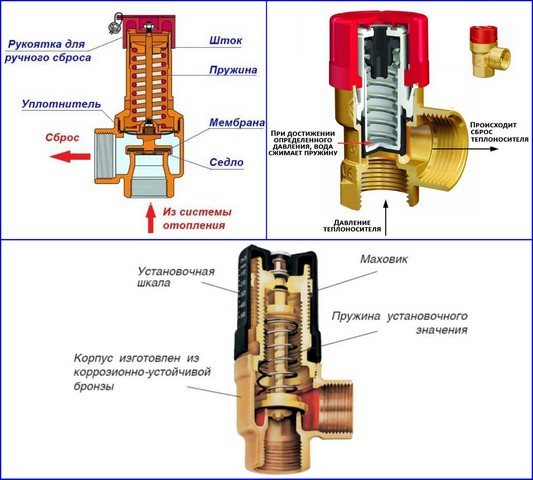

Designs of various models of drain valves
What is the working principle of a gas boiler thermostat?
In modern heating systems, all processes are controlled by an electronic board. In most cases, it has a place for connecting a thermostat - these are two contacts connected by a jumper. The principle of operation is extremely simple: the contacts are closed - the boiler turns on, open - does not turn on. A jumper in the boiler's standard delivery constantly closes the contacts, and the cycle of operation occurs according to its own logic specified in the settings (for example, by a timer).
In the case when a thermostat is connected instead of a jumper, the contacts are closed or opened according to the logic already set by the thermostat. It turns out a switch that either mechanically or electronically closes and opens contacts instead of a jumper.
If the temperature of the room in which the thermostat is installed is lower than the preset one - the switch closes and the boiler starts up, as soon as the temperature rises to the required one - the contacts will open and the boiler will turn off the burner. The principle can be seen schematically in the figure.
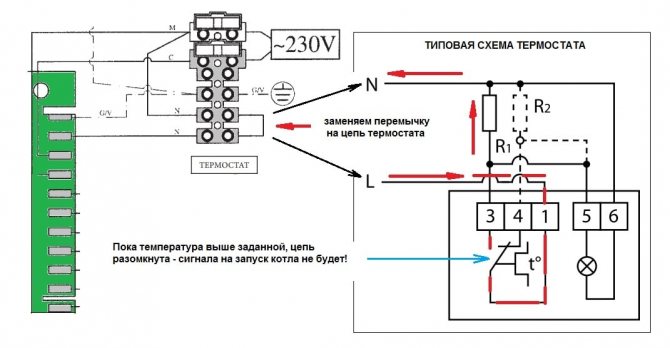

Depending on how the room temperature is measured, thermostats can be mechanical or electronic. The main difference is the accuracy of the readings themselves and the possibility of additional adjustment. Electronic room thermostats allow a more flexible approach to temperature control and have the functions of programming operating modes at different times of the day or on different days of the week.
For example, lowering the temperature in some rooms during the day, even by several degrees, can give tangible savings in gas consumption over a long period of time.
Kau triple thermostatic valve
There are two types of thermostatic valves:
- mixing
- flow A entering the valve is divided into flow B and flow AB - distributive
- stream A entering the valve is divided into 2 streams
The mixing valve is installed in the return pipe and the control valve is installed in the supply pipe. The valve is controlled by a thermal head with a thermal bulb.
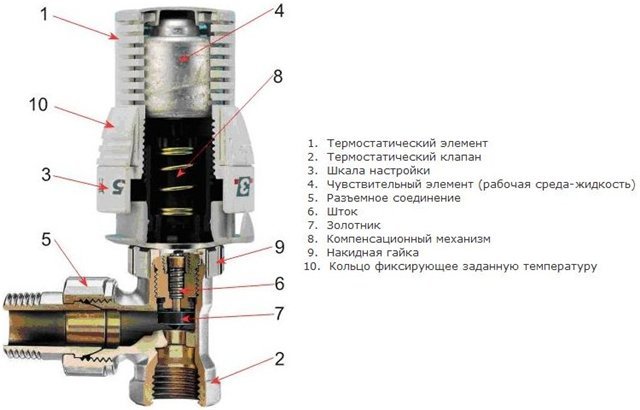

The thermo bulb with the help of a special sleeve is attached to the surface of the return pipe in close proximity to the heating boiler. Inside the flask there is a working fluid, the temperature of which is equal to the temperature of the coolant before entering the boiler. If the temperature of the coolant rises, the working fluid increases in volume, and, conversely, when the temperature of the coolant decreases, the volume of the working fluid decreases. Expanding or contracting, the working fluid presses on the stem, closing or opening the thermostatic valve.
With the help of the thermal head, you can set a certain temperature, above (below) which the heating medium will not be heated. How to set the temperature by choosing the operating modes of the thermal head is described in detail in the instructions for it.
Another feature of the thermostatic valve is that it reduces the flow of the coolant to the boiler, but never blocks it or opens it completely, protecting the boiler from overheating and boiling. The valve is fully closed only at the moment of starting the boiler.
How the thermostat is installed
In principle, installing a thermostat is not difficult, but if you are not sure that you have the necessary skills, it is better to use the services of a specialist.
So, the first thing to do is open the instructions (operating instructions) for the gas boiler and find the layout of the connectors on the board. In the wiring diagram, the location of the thermostat connection point is clearly indicated and it remains only to remove the upper boiler cover and the protective cover of the control board. There are usually no other jumpers on the board itself, and the thermostat connection point is indicated by the letters “Ta”.
Before carrying out work, it is imperative to make sure that the gas boiler is de-energized and there is no voltage at the terminals! Some Internet sources say that the signal voltage for connecting the thermostat from the boiler side is not dangerous 24 Volts - ALWAYS check !!! For example, in BAXI boilers there are exactly 220 Volts !!!
Further, according to the instructions for the thermostat, it is necessary to connect it to the boiler board instead of a jumper and assemble everything in the reverse order. It is better to connect with an insulated copper cable with a cross-section of at least 0.5 mm2.
Some thermostats support the connection of both heating and heating units and there may be several outputs. Those. there will be a fundamental difference in the operation of the switch: what state will be in the initial position - normally closed or normally open. For heating systems, the connection must be made to the normally open initial state. When the temperature drops, the contacts will close, and a signal will be sent to turn on the boiler (as an example, see the connection diagram of the ZONT H-1B GSM thermostat).
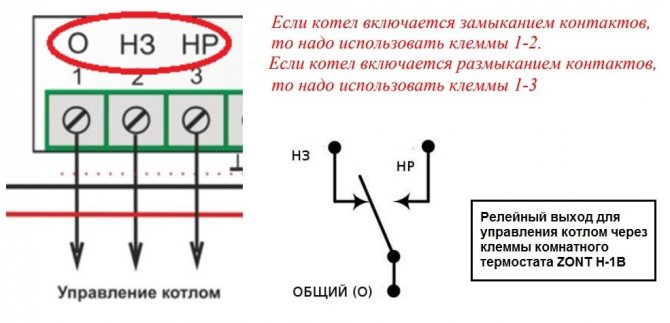

Thermal mixing valve design and operating principle
Like most parts and structural elements of a solid fuel boiler, a three-way or also has a simple and understandable design. It includes:
- main building;
- spring loaded stem;
- two dampers, disc type;
- thermostatic element (head with fixed positions).
The diagram shows the mechanism in detail in a section, where and how its main elements are located.
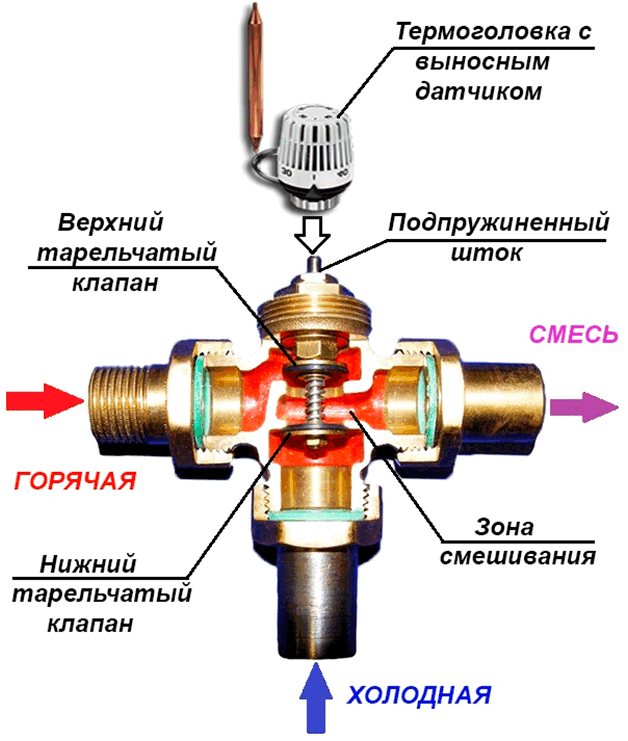

Looking at the design of the device it is not hard to understand the principle of operation. Let's consider in more detail the ongoing processes.
In the normal operating mode of the heating system, the main dampers located linearly are in the open position.Insufficiently hot water flows freely from the boiler into the heating circuit.
The thermostatic head, equipped with a temperature-sensitive liquid sensor, is in the standard position. In the event of an emergency situation, for example: from the side of the boiler, a coolant begins to flow into the system, the temperature of which exceeds the specified parameters. The temperature control sensor is triggered, driving the stem. The operating mechanism closes the main, direct-flow passage, simultaneously opening the passage from the side, through which cold water enters. As a result of mixing water of different temperatures, the temperature is equalized to the set rate. The coolant, already at normal temperature, leaves the device through a pipe to the heating system. The adjustment of the thermostatic head of the device is determined by the degree to which the bellows with the expanding liquid is pressed on the stem. Determines the sensitivity of the device accordingly.
The moment the device is triggered is determined by adjusting the head set to a certain temperature.
If the water continues to heat up as a result of the actions taken, the device shuts off the main inlet flow, opening the access of cold water from the third pipe. The stem in this case is in the lowest position. Water from the third branch pipe is already mixed into the main stream. When the temperature of the coolant changes downward, the stem under the action of the sensor reduces the pressure, opening access to hot water.
In order to achieve the correct operation of the entire mechanism, it is necessary to precisely comply with the requirements for its installation. It can be installed in a right-hand or left-hand version, both on the return and on the supply circuit. During operation, the device does not require maintenance at all.
Why are thermostats installed in the heating system?
- As noted above, thermostats are needed to automate combustion processes and transfer temperature to radiators or warm floors. In addition, it also performs a safety function, because due to the fact that such a regulator controls the temperature of the coolant, it prevents accidents associated with high temperatures.
- It is also necessary to understand: in order for the heating system to work as efficiently as possible, it is necessary to dynamically change the temperature of the coolant in accordance with external factors on the street and in nature. It is the thermostat that helps to change the temperature depending on what is happening outside. Is it warmer outside? - No problem! The temperature in the room changes if the thermostat has the appropriate parameters, and if it has such a function at all. After all, depending on the cheapness, the options change. In tandem with a thermostat, a thermal regulating sensor is used for such purposes.
Why the valve can leak
The pressure relief valve in the heating system can leak for various reasons. In some situations, this is an acceptable natural process, in other cases, a leak indicates a malfunction of the device.
Leakage of the protection valve can be caused by the following reasons:
- Damage to the sealed rubber cup, disc as a result of repeated use. If during repair the replacement part cannot be found on sale or it is not included in the package, you will have to change the device completely.
- In spring types, the opening of the side drain pipe occurs gradually, with boundary pressure values or short-term surges, the valve may partially work and drip, which does not indicate a malfunction.
- Leakage can be caused by incorrect settings or malfunctions of the expansion tank - damage to its membrane, air escaping through a depressurized housing or a damaged nipple.In this case, sudden pressure surges are possible as a result of water hammer, causing periodic short-term flow of the coolant through the safety valve.
- Some adjustable valves are leaking because fluid seeps down the stem from the top during actuation.
- If a back pressure is created at the branch pipe above the instrument response threshold, a leak also occurs.
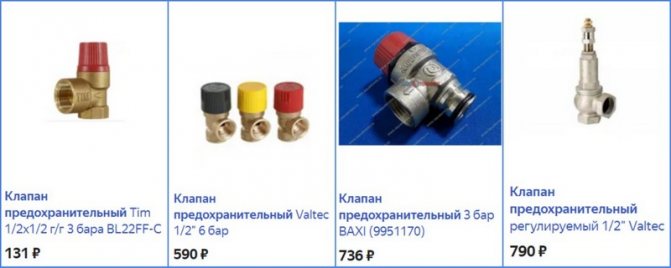

Appearance, cost of some brands of drain valves
The safety valve of steam boilers is designed to protect them from overpressure in the system caused by various factors, and is an indispensable element in the operation of this type of equipment. A wide range of safety devices from Chinese, domestic and European manufacturers are available for sale at a relatively low cost. When buying, it is rational to choose a protective group from several devices, which additionally include a pressure gauge and an air bleed valve.
Requirements for operation
When connecting a three-way valve to a boiler that runs on solid fuel, you must strictly follow the rules for operating the system:
- Periodically conduct a thorough inspection of the system to ensure that it is working smoothly.
- Do not allow the equipment to be used for other purposes.
- All equipment for the heating system must comply with the technical capabilities of the heating boiler.
- Do not install shut-off valves between the expansion vessel and the heating system.
- In order for the boiler to comply with the rules for safe use, the heating system is equipped with an emergency reset valve, which is urgently triggered when it is necessary to lower the pressure in the heating system.
- For ease of installation, the direction of movement of the coolant with a three-way thermo-mixing or distribution valve is shown on the device body with arrows or letters. Install the device in the heating system only in the indicated directions. Failure to comply with this rule can cause damage to the entire system and even an explosion of the boiler.
Installation of a three-way thermostatic mixing valve for a solid fuel boiler is also done in the case of simultaneous connection of several heating circuits with different temperature indicators. Quite popular esbe three-way valve, which is very reliable and practical to use.
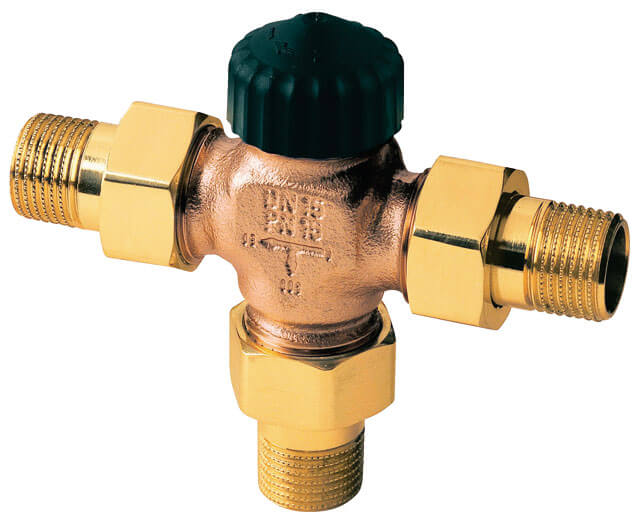

All of these requirements must be strictly observed in order to increase the service life of all heating system equipment and ensure safe and efficient operation.
Water dripping from the safety valve. What to do
Accumulative water heaters today are in great demand among our compatriots. These units simply allow them to effectively solve many economic problems, but sometimes it happens that the device itself becomes the source of the problem.
One of the most common problems that one has to face is water leakage. If water drips from the safety valve, then, as soon as possible, it is necessary to establish the cause, because in some cases this process should not be considered a malfunction. That is why there is no need to rush to the decision to call a water heater repair specialist.
Possible causes of the malfunction
The reasons for water leakage from the valve can be:
- Valve malfunction;
- Incorrectly set pressure difference in the system;
- Other reasons, in particular, water may flow out of the valve, but this will not be considered a failure.
The first two reasons involve the repair of the unit.
Troubleshooting methods
Gas water heaters should be tested first. It is necessary to determine in what situation the outflow of water occurs.
If you noticed that water flows out during the heating of water, then, most likely, your unit is completely operational.The fact is that when heated, the water expands, respectively, the pressure of the liquid on the tank walls increases
When the pressure exceeds the norm, the valve gets rid of excess water. The solution to this problem can be the connection of a rubber hose and its output to the sewer or a container of the required size.
If the safety valve of the water heater passes cold water, then most likely the reason is that the pressure in the water supply is too high. The solution to this problem is to install a reducer to normalize the pressure in the water supply network. To do this, you must contact a qualified specialist. Also, you cannot do without the help of a professional if you are inclined to conclude that the cause of the water leak is a malfunction of the valve itself.
Thus, the first step to solving problems with water leakage from a water heater is to establish the cause of the leakage and establish the nature of the malfunction. Remember that it is always safer to turn to a professional for help than to repair complex equipment on your own, because inept repairs can lead to a more complex malfunction.
Where to install a 3-way valve and when it is not needed
Before choosing a three-way valve, it is advisable to make sure that it is really needed. Indeed, on the Internet and in real life, there are enough advisors who poorly understand the essence of the issue. So, let's list the situations when this valve is really needed:
- To protect the solid fuel boiler from the supply of cold coolant and condensation on the inner walls of the furnace.
- To regulate the temperature of the water in the heating circuits.
- To limit the heating of the coolant in the underfloor heating circuits.
A lot has been said about condensate, provoking the formation of sticky build-ups on the walls of the TT-boiler chamber, including on our resource. It appears during the heating process, when the temperature in the furnace is already high, and cold water comes from the heating system. To avoid this, the supply and return lines are connected by a bypass, where a 3-way valve is installed. It forces the coolant from the boiler tank to flow in a small circle, and only when heated to 50-60 ° C does it begin to mix water from the system.
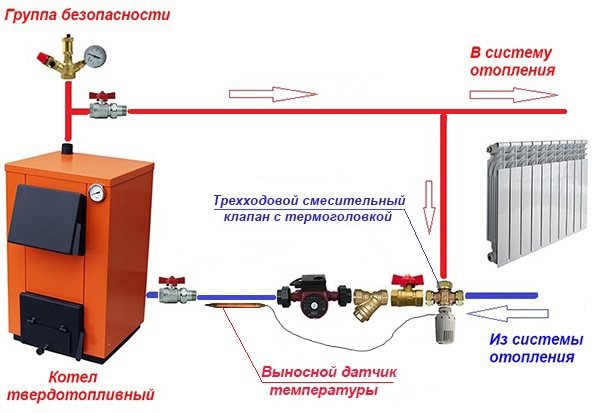

A circuit with a bypass and a mixer protects the TT boiler from condensation and temperature shock
Important note. The valve serves as a safety element for the cast iron heat exchanger, if one is installed in your heat generator. Imagine that the electricity in the house is turned off for 1-2 hours, during which the radiator network has time to cool down. Without a mixer, cold water will suddenly flow into a preheated boiler when the power supply resumes. From such a drop, cast iron will experience a temperature shock and may crack.
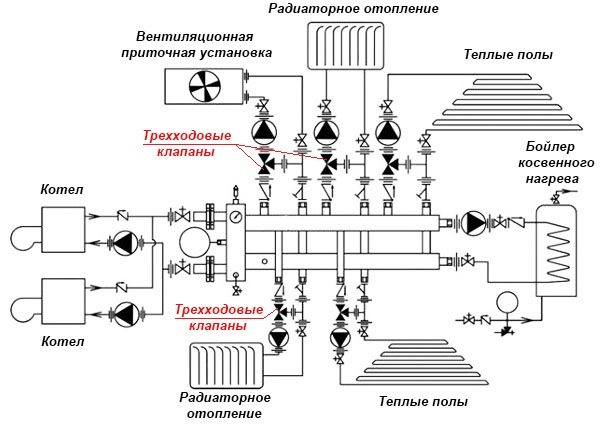

System with several heating circuits operating in different modes
Temperature control in heating circuits with a mixing set is necessary in the following cases:
- in complex heating systems, when several lines with different temperature conditions must be connected to a common comb, for example, a radiator network, underfloor heating and an indirect heating boiler;
- when connecting the same consumers to a buffer tank - a heat accumulator;
- when supplying heated water to the heat exchanger of a ventilation air supply unit used for air heating of a country cottage.
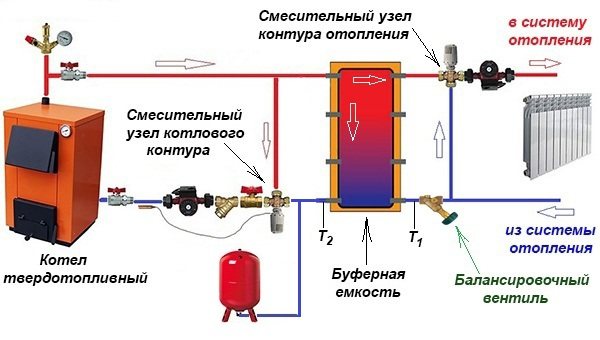

The valve in the heating circuit not only regulates the flow temperature, but also allows the boiler to heat the heat accumulator
Since a heat carrier with a temperature of no more than 50 ° C is sent to the heating circuits of underfloor heating, and 85 ° C can come from the boiler, then it should be limited. Usually (but not always!) The issue is solved by installing a mixing unit with a 3-way valve on the distribution manifold. The latter mixes the chilled water from the floor circuits with the "external" heat carrier coming from the boiler.
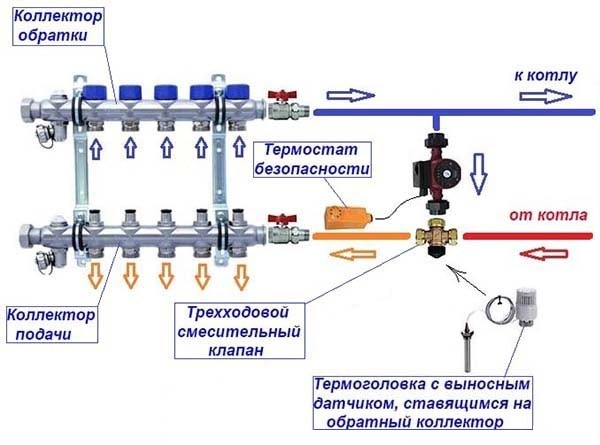

The scheme of preparation of water of the required temperature for feeding into the loops of underfloor heating
Now let's designate the situations when the purchase and installation of a mixer (or separator) is not necessary:
- If the length of each loop of the underfloor heating water does not exceed 50-60 m, which is quite possible to achieve, then the regulation is done without a mixing unit. Instead, RTL-type heads are placed on the return manifold, limiting the flow by the amount of coolant.
- When 2-3 heating units alternately operate to heat a private house, maintaining a constant temperature in the network not lower than 40 ° C, then there is no need to install a three-way valve for a solid fuel boiler.
- In heating systems with natural water circulation. The reason is the pressure drop across the valve, which impedes the movement of the coolant. The same applies to heat accumulators operated by gravity.
Note. In gravity systems, pipes of increased diameter DN40— DN50 are used. This means that they will have to buy not an ordinary sleeve mixer, but a bulky flange-type valve at a decent price. Such a decision cannot be called reasonable.
If you are interested in why it is better to choose RTL heads and how they control floor heating circuits, watch a video from an experienced craftsman and our expert Vladimir Sukhorukov:
Nominal diameter and adjustment
The flow area of the safety valve must be equal to or greater than the cross-section of the pipe on which it is installed. Otherwise, the hydraulic resistance of the device will be too high, as a result of which the operation of the system will be disrupted.
The adjustment of the heating system safety valve depends on the type of pressure mechanism. In spring devices there is a cap, the rotation of which sets the pre-compression of the spring. These products are characterized by a high control accuracy of +/- 0.2 atm.
Lever weight valves are less accurate. To do this, you need to move the weight along the lever or increase its weight.
Fig. 3. Independent connection diagram of ITP with pressure maintaining device
Such a scheme is somewhat more expensive than a dependent one, but at the same time it protects indoor heating devices from low-quality coolant coming from the central network. If, in addition to heating, it is necessary to provide centralized hot water supply, then one or more heat exchangers are additionally installed. Depending on the ratios of the heating load and hot water supply, one-stage and two-stage water heater connection schemes are used.
Examples and ROI
In Ukraine, modern automated heating units with an independent connection scheme are offered by the Austrian company Herz.
IHPs from Herz operate at a supply water temperature in the primary circuit (district heating) of 110–140 ° C / 65–80 ° C. At the same time, the temperature in the in-house heating system is maintained at 90–55 ° C / 70–45 ° C. The nominal pressure in the primary circuit is up to 16 bar. The operating pressure in the secondary circuit is from 2 to 10 bar. To maintain the pressure in the system, a diaphragm expansion vessel is used or, in the case of systems with a capacity of more than 300 kW, a pressure maintenance unit. The circulation of the heating medium is carried out by highly efficient frequency-controlled pumps.
The ITP configuration includes schemes based on a two-way valve or a combi-valve - an electric flow regulator, and a plate or brazed heat exchanger. Weather-dependent regulation of the coolant temperature, temperature settings are carried out by the controller. At the same time, it is possible to organize remote access and control of equipment via a GPRS modem. To account for heat consumption, an ultrasonic flow meter with a computer is provided.
Apart from ITPs, apartment heating points are also used for multi-storey buildings.They allow the consumer to individually regulate the operation of the heating system and hot water supply, and provide the convenience of metering the consumed energy. For example, the Herz DeLuxe substation is designed for a maximum operating temperature of 90 ° C, a maximum operating pressure of 10 bar and provides a hot water flow of up to 15 l / min. Such heating points are installed directly for each consumer (apartment). There are options for open or hidden installation in the wall, as well as with a mixing unit for low-temperature radiant panel heating, for example: warm walls, underfloor heating (Fig. 4).
Fig. 4. Compact apartment heating station Herz Bregenz
The payback time for ITP investments for building retrofits ranges from 1 to 5 years and depends on the equipment used, the size of the building and the type of system. It should be remembered that the installation of individual heating points is an important and necessary step, but not the only one on the way to the energy efficiency of the heating system of a residential building. The greatest effect is achieved together with balancing the heating system and installing thermostatic valves on heating devices.
Views count: 5 337
Basic principle of boiler protection against condensation
To protect the solid fuel boiler from the formation of condensation, it is necessary to exclude a situation in which this process is possible. To do this, do not allow cold heat carrier to enter the boiler. The return temperature should be less than the flow temperature by 20 degrees. In this case, the supply temperature must be at least 60 C.
The easiest way is to heat a small amount of coolant in the boiler to the nominal temperature, create a small heating circuit for its movement and gradually mix the rest of the cold coolant with hot water.
The idea is simple, but it can be implemented in various ways. For example, some manufacturers offer to purchase a ready-made mixing unit, the cost of which can be 25 000
and more rubles. For example, the FAR company (Italy) offers similar equipment for
28,500 rubles
and the company
Laddomat
sells a mixing unit for
25,500 rubles
.
A more economical, but at the same time no less effective way to protect a solid fuel boiler from condensate is to regulate the temperature of the coolant entering the boiler using a thermostatic valve with a thermal head.
Purpose of thermostats and characteristics
The operation of this device is based on the principle of turning on and off the heating boiler. Prior to this, a thermal sensor is installed in the device. This device is easy to operate and at the same time demonstrates sufficient reliability
to control the temperature in the rooms of the house.
The main advantage of using a thermostat as part of a heating system is the ability to reduce energy costs.
In this case, it does not matter whether the unit is running on gas or is powered by electricity. According to such a parameter as a functional purpose, all thermostats are divided into two types:
- manual;
- programmable.
Which thermostats are better
Hand-held instruments are supplied on and off button
... In addition, the thermostat has a dial for adjusting the required temperature level, which is manually rotated.
Programmable thermostats have more complex device
... However, this does not mean that their use is problematic. Complex designs give more options that become available to the owner using a heating system with a built-in thermostat.
One of these is turning on and off the boiler in automatic mode at regular intervals that are configured by the user.
Principle of operation
The valve protecting the boiler has a simple design and works according to a principle that is understandable even for a schoolchild. The instrument consists of a straight fitting with a 90 degree elbow and a spring-loaded, pressure-tight seal that closes off the side passage.When the pressure in the system increases from overheating, exceeding the clamping force of the spring holding the valve in a stationary position, it rises up and opens the side hole.
Excess liquid begins to pour out from the side and is sent to a container, drainage or sewer system. After venting part of the coolant, the pressure in the system and on the valve weakens, the spring puts it in place, blocking the side pipe.
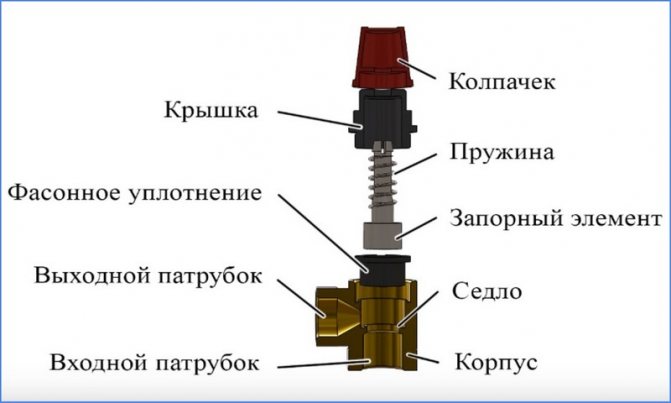

Spring type constructive device

